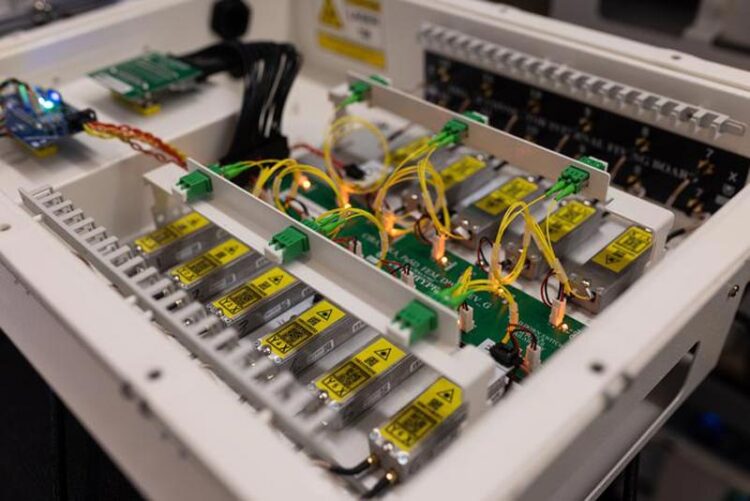‘Radio-quiet’ electronics to power the world’s largest radio telescope

The electronic board designed and built by the Curtin ICRAR engineering team.
Credit: ICRAR
A team of researchers, engineers and technicians has developed a ‘SMART box’ to power the world’s largest radio telescope.
The Power and Signal Distribution (PaSD) SMART boxes (Small Modular Aggregation RFoF Trunk) are an essential component of the Square Kilometre Array Low frequency (SKA-Low) telescope, currently under construction at Inyarrimanha Ilgari Bundara, the CSIRO Murchison Radio-astronomy Observatory, in Western Australia.
The SMART boxes provide electrical power to the SKA-Low telescope’s 131,072 antennas and collect signals received from the sky to go off-site for processing.
The Engineering & Operations team at the Curtin University node of the International Centre for Radio Astronomy Research (ICRAR) designed and built the first set of 24 SMART boxes, which were 10 years in the making.
Tom Booler, Program Lead for Engineering and Operations at ICRAR, said they are the only electrical devices that must be placed among the antennas, creating a challenge for this sensitive equipment.
“The SKA-Low telescope will receive exquisitely faint signals that have travelled across the Universe for billions of years,” he said.
“To detect them, the SKA-Low telescope is being built in a pristine radio quiet zone far from the interference created by modern technology.
“It’s so radio quiet at the observatory site that the biggest potential source of interference is the electronics like ours, due to the proximity to the antennas. That meant our project had to meet the strictest radio emission requirements across the entire Australian SKA site.”
The team had to source special ‘radio quiet’ parts that emit minimal interference, replacing the more ‘noisy’ ones. The parts were then wrapped in a specially designed case to prevent any stray radio waves from escaping.
The boxes were tested at a dedicated electromagnetic test facility in South Africa, where they passed with flying colours.
“The ‘radio quiet’ results that the ICRAR-designed SMART boxes achieved were to the highest standards in radio astronomy. A mobile phone on the surface of the moon would cause more interference to the antennas than the SMART boxes that sit among them,” Mr Booler said.
A contract to build up to 12,000 SMART boxes for the entire fit-out of the SKA-Low telescope was recently awarded to Perth-based company AVI after a competitive tender process. This is the biggest contract in Australia for SKA construction, outside infrastructure and software, realising the benefits intended from the Australian Government’s investment into SKA pre-construction activities over the past decade.
Mr Booler said he was pleased to see that the SMART boxes would be built in Western Australia, a promising indication of Australia’s sovereign capability in the space industry, and one that could be leveraged into the future.
AVI Managing Director, Tony Routledge said the company was proud to be involved.
“Being part of the SKA project is an incredible opportunity for AVI to contribute what we have learnt over our thirty-five years of delivering hardened electronic systems to the defence, security and mining sectors. Harsh environments are our specialty. Extreme temperatures, ingress protection and the low noise requirements, coupled with the remoteness of this location offer more opportunities to learn and evolve” he said.
“I think we are all eager to be a part of what findings may eventually be revealed by the radio telescope.”
We acknowledge the Wajarri Yamaji as the Traditional Owners and native title holders of Inyarrimanha Ilgari Bundara, the CSIRO Murchison Radio-astronomy Observatory site where the Murchison Widefield Array is located.
MORE INFORMATION
ICRAR
The International Centre for Radio Astronomy Research (ICRAR) is a joint venture between Curtin University and The University of Western Australia with support and funding from the State Government of Western Australia.
The SKA Observatory
The MWA, ASKAP and MeerKAT telescopes are all precursors to the SKA telescopes that are being constructed in Australia and South Africa by the SKA Observatory (SKAO). The SKAO is a mega-science facility that will transform our understanding of the Universe
Australia is hosting the SKA-Low telescope, which is being built at Inyarrimanha Ilgari Bundara, the CSIRO Murchison Radio-astronomy Observatory, on Wajarri Country. SKA-Low will comprise 131,072 two-metre-tall Christmas tree-shaped antennas receiving low-frequency radio waves over an area of 74km end-to-end.
AVI
AVI designs, engineers, manufactures and tests specialised zero-fail communications systems, to provide accurate and high-assurance solutions for sustained and trusted performance in hostile environments.
AVI is a privately-owned wholly Australian company, headquartered in Perth, Western Australia.
Media Contact
Charlene D’Monte
International Centre for Radio Astronomy Research
communications@icrar.org
Cell: 0468 579 311
Original Source
All latest news from the category: Physics and Astronomy
This area deals with the fundamental laws and building blocks of nature and how they interact, the properties and the behavior of matter, and research into space and time and their structures.
innovations-report provides in-depth reports and articles on subjects such as astrophysics, laser technologies, nuclear, quantum, particle and solid-state physics, nanotechnologies, planetary research and findings (Mars, Venus) and developments related to the Hubble Telescope.
Newest articles

First-of-its-kind study uses remote sensing to monitor plastic debris in rivers and lakes
Remote sensing creates a cost-effective solution to monitoring plastic pollution. A first-of-its-kind study from researchers at the University of Minnesota Twin Cities shows how remote sensing can help monitor and…

Laser-based artificial neuron mimics nerve cell functions at lightning speed
With a processing speed a billion times faster than nature, chip-based laser neuron could help advance AI tasks such as pattern recognition and sequence prediction. Researchers have developed a laser-based…

Optimising the processing of plastic waste
Just one look in the yellow bin reveals a colourful jumble of different types of plastic. However, the purer and more uniform plastic waste is, the easier it is to…


